Once upon a time, in the dim mists of history there lived a monk named Kevin.
Seriously.
Back in the late 500’s, Kevin, looking for a bit of peace and quiet to contemplate his spirituality, found it in a remote valley in an area now called Glendalough. Kevin looked for a quiet existence, but word of a holy man in the wilds spread, and soon acolytes and fellow seekers came to join him.
So much for being a religious hermit.
A monastery was built, and over the years a series of churches and supporting buildings were added. And at the entrance to the grounds, a gate.
Back in the day, folks who had run afoul of the law would seek sanctuary in churches and monasteries. Once they reached the gates of Glendalough the monks gave them an offer: they could have sanctuary for a year, but after that, they either must leave or take up the brotherhood. After that year many of the outlaws, enjoying the peace and stability of maintaining the monastery, decided it was a better life than the one they ran away from. And so the compound grew.
1500 years later, a different sort of pilgrims descended on that same valley. Turning on our time machine, we looked for vestiges of Kevin and his followers.
The tower is a rather pronounced vestige. Nearly 100 feet high, you’d need to be quite tall just to enter the door; it’s 10 feet off the ground. The tower originally had six timber floors, connected by ladders. The four stories above the entrance level are each lit by a small window. The top story has four windows facing the cardinal compass points. Towers such as this were landmarks for approaching visitors or served as bell towers, but also were used as store-houses and as places of refuge in times of attack.

Despite several attacks by Vikings between 775 and 1071 the monastery flourished for its first 600 years or so, and along with Clonmacnoise became one of the two leading monasteries in Ireland. Most of the buildings that can be seen today were built in the 1000-1200 era. At the Synod of Rath Breasail in 1111, Glendalough was designated one of two dioceses of the province of North Leinster, and Kevin’s legacy grew.
Glendalough thrived as one of Ireland’s great ecclesiastical foundations and schools of learning until the Normans destroyed the monastery in 1214. After the attack the dioceses of Glendalough was moved to Dublin, and the cultural and religious status of Glendalough declined as the status of the Dublin dioceses expanded. The settlement was destroyed again by English forces in 1398, but even as a ruin it continued to be a local place of worship and a pilgrimage destination.
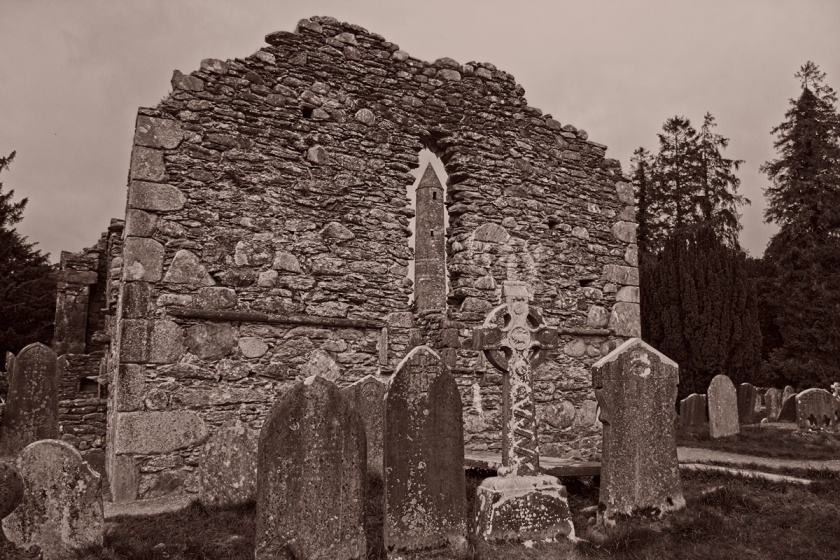 For 500 years, Glendalough remained in decline. Then, in the late 1800’s a reconstruction project began.
For 500 years, Glendalough remained in decline. Then, in the late 1800’s a reconstruction project began.
In addition to the ruins of churches, the grounds have become a cemetery. The local high and mighty apparently considered it a final resting place of high repute, equivalent to being buried at the Vatican. While most of the headstones are from hundreds of years past, a few modern ones poke up here and there, short-circuiting our time machine and returning us to the present.
Although now located in Dublin, the dioceses of Glendalough survives to this day. Kevin, in a way, has survived all these many years.
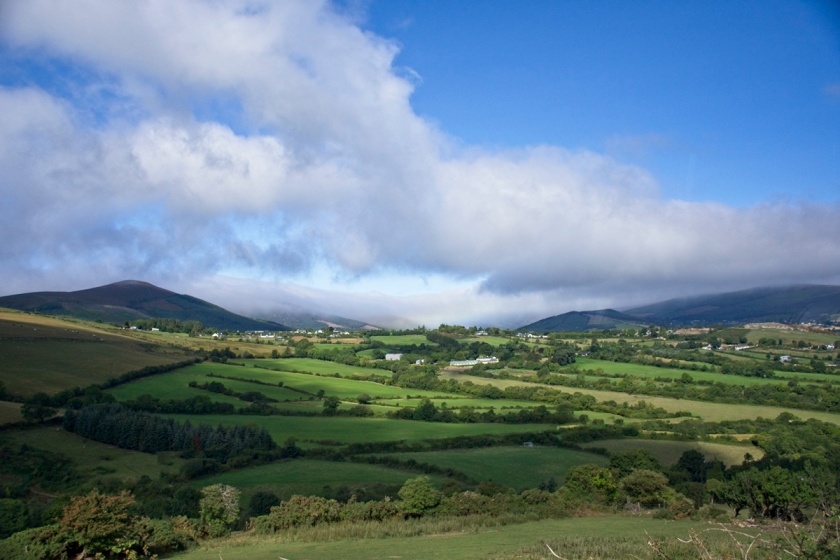
And as for his choice of landscape, the route leading to Glendalough is no longer wild, and the Wicklow mountains and valleys provide a place of scenic beauty.


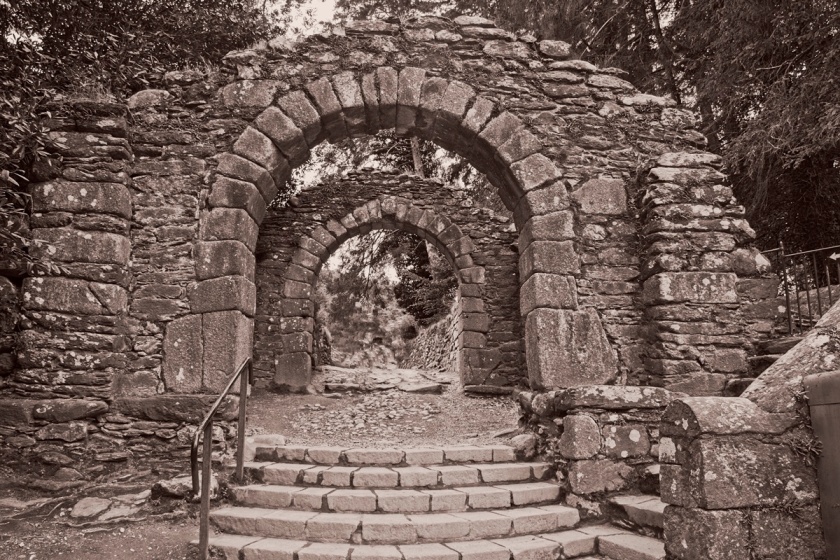
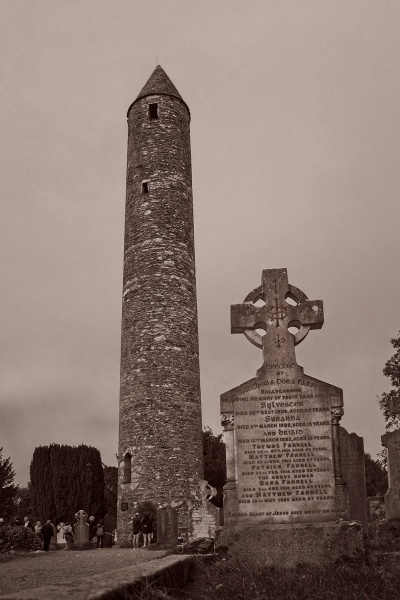
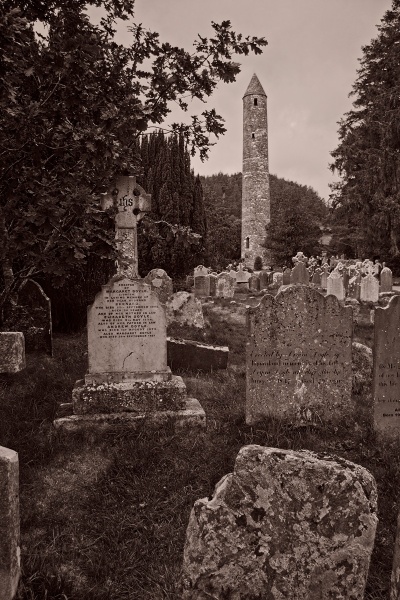

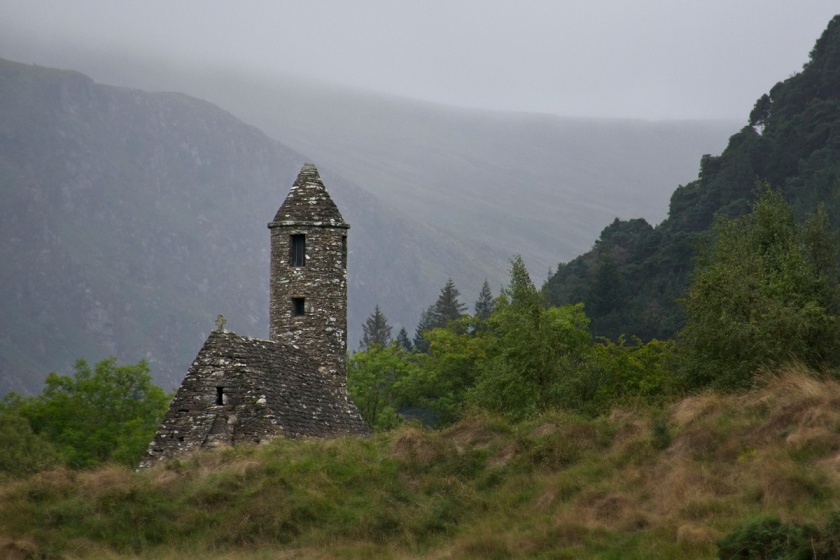
What a fascinating place to visit! You can practically feel the history through your photos!
LikeLiked by 1 person
Thanks, Carly. That’s the feel I was going for.
LikeLike
Quite a history. It’s so interesting what any old edifice might hold. Thank you!
LikeLiked by 1 person
That’s one of the interesting things about travelling to Europe. Compared to the United States their history goes back mind bogglingly far.
LikeLiked by 1 person
Every shot is terrific, what a beautiful area. The tower framed in the window is perfect. I can see the care they took in on those walls, carefully fitting together rough fieldstones.
So the ten-foot-high doors are in case of surprise visits from Vikings?
LikeLiked by 1 person
I suspect there was many a rock wall fitting specialist back in the day. Especially in the north of Ireland, we saw loads of fields with rock walls, hand fitted where you’d find barbed wire in our own barbarous country. I understand the art of rock fitting (as well as thatching) are dwindling away.
Yes, I image the ten foot high doors are in case of Vikings, local greedy lairds, passing riff-raff, and possibly the landlord. Probably easier than building a moat and drawbridge.
LikeLiked by 1 person
Hi Dave!
This was a great post! I enjoyed reading it very much, and the pictures are beautiful. Makes me want to go there.
Fun fact: I chose St. Kevin as my patron saint when I was baptized as a young boy. When I was trying to choose a saint and the priest was reeling off a list of them with a one- or two-word description of what they were patron saints of, when he said “patience”, I chose that one, because I had very little of it at the time. Or now.
In retrospect, I think it was a very good choice for me. The reason for this can best be described from the following passage (stolen shamelessly from Wikipedia): “… following his ordination, he moved on to Glendalough in order to avoid the company of his followers”. I, too, am quite uncomfortable around people.
I used to dream of being a hermit, but I found out that it didn’t pay very well.
Also, the story of St. Kevin and the blackbird also makes him quite appealing as a patron saint.
Great post! Thanks for sharing.
LikeLiked by 1 person
Biff! You’ve been holding out on us. All this time it’s really been Biff Sock Kevin Pow. Guess the Kevin part has successfully been a hermit, hiding away all this time.
I’m glad it struck a chord. 🙂
LikeLiked by 1 person
It did! Very much. I would love to go to Ireland and you wrote about it so well.
I have written a few times in my blog posts that I would love to be a hermit. Albeit a hermit with all of the creature comforts (air conditioning, lots to eat, a comfy chair, etc.). In reality, I would not have made a very good hermit. I’ve got the “don’t care for crowds” thing down pat, but I like creature comforts too much.
LikeLiked by 1 person
I understand Kevin barely ate anything, wore animal skins, and slept on rocks. But his cave was probably air conditioned…
LikeLiked by 1 person
Kevin sounds like the original hippy.
LikeLiked by 1 person
What a clever idea to turn a pictorial journey into an imaginary story even with time travel!
LikeLiked by 1 person
Hi Peter. I’m not actually that clever. Except for giving the pictures an old timey look and invoking a time machine, Saint Kevin and the history is for real.
LikeLiked by 1 person
Thanks for the clarification, Dave!
LikeLiked by 1 person
I was particularly fascinated by the idea that Kevin wanted to be a hermit and a community grew up around him.
LikeLiked by 1 person
It’s tough to be an introvert when you’re famous, and if your fans have religion…
LikeLike
It looks peaceful – but bleak. Maybe it is just the black and white photos or maybe the lack of color tells a lot about the place. Well done.
LikeLiked by 1 person
And all those old tombstones don’t exactly make it cheery. But even without doing it in B/W with a bit of toner, it was a gray day.
LikeLike
I love this place and the Wicklow mountains. It appears that you listened to the tour guide. Something I have a hard time doing. As a result, I’ve just learned more about the place from you than I did when I was actually on the tour. Kevin does seem to be a strange name for a monk. I’d expect it to at least be spelled “Kevyne” or something. And 1111…what a year. Love the monochrome on the photos.
LikeLiked by 2 people
I did listen to the guide, but I used Google to refresh the details. About the only item the guide mentioned that didn’t pop up in the searches was the sanctuary choice. It does seem like Kevin would be an odd name for that era, and the fact they’d be speaking gaelic – I suspect the actual name would be spelled differently. I thought I’d give the toned monochrome a whirl, just to see if I could get an old timey feel.
LikeLike
The way you’ve done the photos really brings back the 500-yo mood! I never really thought about what kinds of people decided to spend their lives in monasteries; I guess I assumed they were all from religious families. Interesting history and beautiful current-day spot!
LikeLiked by 1 person
Thanks, Lex, I was hoping the tone would invoke an old timey feel. I suspect there are many reasons for going to a monastery, but I’d guess not being a first born son that inherits land, or looking for the spiritual cachet that might come from being associated with the church might be a couple reasons. The drive up to the ruins was one of the more scenic we did on the trip.
LikeLiked by 1 person
Fabulous! Thanks for sharing part of the fascinating history of Ireland.
LikeLiked by 1 person
Glad you liked it, Ann. Who’d of thought some old monk would be interesting?
LikeLike
The first few pictures looked a little eerie, especially the shot of the cemetery. 🙂 The sepia tones blend well your narrative of the place and those stony structures. But, it was the last few shots of the blue sky and green pastures that stole the show for me! 🙂
LikeLiked by 1 person
I figured after all that hoary old history and spooky old graveyards a bit of color would be a refreshing finish. Everybody likes a happy ending. 🙂
LikeLiked by 1 person
Hey Dave, I found your travel blog through CJ Hartwell’s site. I really like your educational travel approach and your eye for photography is excellent.
LikeLiked by 1 person
Hi Joe, nice to meet you. Sometimes my posts will have an educational aspect, sometimes I’ll go other directions. Photography tends to drive the stories, it’s been a hobby since I was a kid.
LikeLike
Beautiful photos, Dave, and they are matched with your wit and writing ~ I’d have liked to share a beer with Kevin back in the day, what a great history.
LikeLiked by 1 person
Thanks, Randall. I suspect Kevin would have shunned beer, and probably wine too unless it was for communion. I read he barely ate anything and wore animal skins. Not exactly Friar Tuck.
LikeLike
It looks a fascinating place, Dave. I never managed to get an opportunity to go there. Out of interest, in reference to Randall’s comment, back in the day monks, in common with the entire population, would have drunk beer as a matter of course. It was safer than water.
LikeLiked by 1 person
Tis true, back in the day folks would drink beer rather than water as it could be more sanitary – especially in cities. But I suspect in the wilds that Kevin lived in, especially with a couple lakes nearby, that the water was safe. As the centuries piled up and the population increased that may have changed.
LikeLiked by 1 person
I can’t answer for Ireland, of course, but in most monasteries they brewed their own beer as a matter of course – Cellarer was an important post – but if the water was fresh I’m sure they would have drunk it. And talking of lakes, ain’t that a cue for a fish story?
LikeLiked by 1 person
I’m not sure if this was true for all monks, but I understand the German ones came up with Doppelbock as a way to provide a little extra sustenance during periods of fasting. As for fish stories, here’s an old one for you.
LikeLiked by 1 person
I’d forgotten that one, Dave. It’s a good one and I’m glad the fish got away!
LikeLiked by 1 person
Wow these photos are amazing – that graveyard! I’d love to take a stroll through there.
LikeLiked by 1 person
That’s not something you hear everyday. Must be all that time you’ve spent on old battlegrounds – the history overcomes the spookiness.
LikeLiked by 1 person
Yes, my husband and I both have a thing for walking through old graveyards. We’ve accepted that we’re odd 🙂 But we do love the history!
LikeLiked by 1 person
I’m currently reading a book (de Hamel’s “Meetings with Remarkable Manuscripts”) where Irish monasteries are given quite a lot of prominence. I never knew that it was Irish monks who actually sailed to spread the Gospels in England and even Europe. Quite refreshing to find a Kevin (who cannot but be named Kev!) amongst all those Aoife, Bede, Columba and all those incredibly complicated Gaelic names.
LikeLiked by 1 person
Those Irish missionaries get around – even these days. My wife grew up in the Philippines and went to Catholic schools there. The staff? Irish nuns.
LikeLiked by 1 person
That’s some fascinating history – enough to make me want to go if I get to Ireland…and those last two photos are just beautiful.
LikeLiked by 1 person
Living in a country that’s only 250 years old or so, it’s kind of mind boggling when you run into this sort of thing. There’s so little we know about that era.
I figured after the mood of the monochrome shots, something more upbeat would be a nice way to finish. (And I do like beautiful 🙂 )
LikeLike
All you say makes sense, Dave – I would love the age of that site (and others)….and yes, good idea to end with the color images.
LikeLiked by 1 person
A monk named Kevin… sounds like a Monty Python character.
What a fascinating history, as well as location. Must have been a beautiful area to walk around, even with gray skies.
LikeLiked by 1 person
Great, now I will not be able to think of Kevin without visualizing a group of fops twittering away in falsettos, and perhaps an invasion of the Irish Inquisition.
LikeLiked by 1 person
This post is amazing! There’s something haunting about it. The opening line followed by “Seriously.” had be cracking up. The history and the pictures are amazing. Hope to see it one day in person.
LikeLiked by 1 person
🙂 Well, who would think there’d be a monk named Kevin in a gaelic speaking country in the 6th century?
LikeLiked by 1 person
It is difficult to be a hermit in Ireland 🙂 Kevin is quite a popular name here – I don’t know if it is thanks to him. May be not. The crowds of tourists visiting Glendalough every day are his doing though 🙂
LikeLiked by 1 person
The Irish seem to be a sociable lot, I can see how it’d be tough to be a hermit. I just thought “Kevin” seemed a modern name considering all those old tongue twisters. (Do you speak any gaelic?)
LikeLiked by 1 person
No Gaelic, Dave. The youth study it in school, they are good at it. I only know the words that are used in a daily life, like the road or any other signs :). Or like Oireachtas, which is the Parliament 🙂
LikeLiked by 1 person